Read next
The latest news, updates and expert views for ambitious, high-achieving and purpose-driven homeowners and property entrepreneurs.


Here's your issue: you – or your property’s previous owner – made changes without attaining the required planning permission.
Maybe you’ve converted your house into multiple flats unlawfully, or perhaps you added a rear extension to your home without understanding the need for planning permission.
If you didn't realise that you were breaking planning rules at the time, then it can be alarming to discover you've done the wrong thing, and that you could be issued with an enforcement notice at any moment if your local authority learns of these changes.
If you're panicking - take a breath!
The good news is that, in some cases, a Certificate of Lawfulness – long known as a '4-year rule' - application can help you fix your situation.
In this article, you'll learn more about the policy behind the Certificate of Lawfulness process, and how we successfully help our clients navigate what can be a confusing application process.
But before we get there, there is an important update concerning the four-year rule that, if you're reading this article, will likely impact you.
Long story short, the four-year rule was replaced by a ten-year rule on 25 April 2024.
This means that moving forward, any works completed without the required planning permission will need to demonstrate ten years of continuous use rather than four - a far more arduous task.
There are some transitional provisions and if your project was “substantially completed” before 25 April 2024, then the new time limit may not apply to you.
What does “substantially completed” mean?
Great question. Unfortunately - but expectedly - the definition of "substantial completion" remains legally ambiguous and will likely be clarified through future appeals and court rulings.
However, we agree with the Royal Town Planning Institute's (RTPI) guidance, which states that a building is complete when it is finished for the purposes for which it was intended. The RTPI also notes that for phased developments, the legal clock may restart if earlier stages have not been accrued and evidenced - an interpretation that will be tested in the coming years.
A word of caution: while transitional provisions may apply, it’s important to stress that any unauthorised works completed after 25 April 2024 must now comply with the ten-year rule.
That’s the disclaimer done, now let’s continue.

The 4-year rule provides a legal pathway to retrospectively regularise unauthorised development, allowing you to bring your property into compliance with local council regulations.
If successful, this prevents the risk of an enforcement notice, which could otherwise require you to reverse the changes and restore the property to its original state but also lead to hefty financial penalties.
Many landlords unknowingly—or sometimes knowingly—assume that time alone will legitimise unauthorised works. However, councils have been cracking down on such cases, with some landlords facing penalties exceeding £250,000, particularly when enforcement notices are ignored or safety regulations are breached.
In the worst cases, landlords can be ordered to repay years of rental income under the Proceeds of Crime Act, making non-compliance an extremely costly gamble.
To obtain a Certificate of Lawfulness under the 4-year rule, applicants must provide clear and uninterrupted evidence that the property has been in the same continuous use for at least four years prior to 25 April 2024.
This is why the process is commonly known as the '4-year rule' - it relies entirely on proving the passage of time rather than compliance with planning policies.
The four-year rule applies exclusively to unauthorised operational development (CLEUD) and the use of a property as a single dwelling (CLEU, Use Class C3).
A common misconception is that the four-year rule also applies to Houses in Multiple Occupation (HMOs). In reality, HMOs, whether small (Use Class C4, accommodating 3 to 6 unrelated individuals) or large (sui generis, accommodating more than 6 individuals), have always been subject to the ten-year rule, regardless of the changes introduced on 25 April 2024.
Beyond HMOs, the ten-year rule also applies to all other non-C3 uses, including commercial premises and mixed-use properties, meaning a longer period of continuous use must be demonstrated to establish lawfulness.
Nothing is guaranteed when it comes to seeking planning consent, and a Certificate of Lawfulness is no exception.
In order for your application to be successful, your architects or planners need to provide your council with sufficient factual information for them to consider the evidence.
For example, when applying to regularise the conversion of a house into multiple self-contained flats, you must demonstrate continuous, uninterrupted use of the property as separate self-contained flats for at least four years before 25 April 2024.
Proving your case isn’t just about ticking boxes - it’s about presenting a rock-solid timeline of evidence that leaves no room for doubt. The stronger your proof, the smoother your path to securing a Certificate of Lawfulness. Potential evidence includes but is not limited to the following:
A word of caution: these examples are meant to give an idea of the documents required but the list is NOT exhaustive. It is wise to engage the services of professionals with experience in obtaining Certificates of Lawfulness to avoid receiving an enforcement notice from your local council.

A Certificate of Lawfulness is important for owners in this unfortunate situation, because one will definitely be needed if you ever go to sell your property. You also will need it if you ever go to remortgage. And, it prevents you from ever experiencing enforcement action in the future.
But here’s the catch: because a Certificate of Lawfulness is a retrospective regularisation, getting one is more complicated than it sounds.
You will need to provide sufficient factual information to demonstrate that the use in question has continued at the same level of intensity, and for the same purpose, for at least four consecutive years (again, for those not substantially completed before 25 April 2024, this is now ten consecutive years).
We often accompany our evidence with a detailed design and access statement to tell the story of the evidence and make clear what we are proving.
To date, we have prepared, submitted and managed dozens of Certificate of Lawfulness applications, and have maintained a 99% success rate. We look forward to helping you regularise your unauthorised development.

If you’re thinking that the worst that can happen when your property lacks planning permission is being told to undo the work, the recent Pathfield Estates v. London Borough of Haringey case should serve as a serious wake-up call.
In this landmark case, a letting firm that had unlawfully converted a property into six flats without planning permission was hit with more than £250,000 in penalties under the Proceeds of Crime Act (POCA). Yes, you read that right—over a quarter of a million pounds.
Pathfield Estates had converted a property into multiple flats without securing the required planning consent. Despite being served an Enforcement Notice in 2008, they failed to comply fully. Years later, the council pursued a Proceeds of Crime Act prosecution, arguing that Pathfield had financially benefited from the illegal use of the property.
The courts agreed.
Pathfield was forced to pay back the rental income earned during the period of unauthorised use, highlighting a crucial point: it’s not just about fixing planning issues—it’s about the profits made from those unauthorised works.
This case sets a powerful precedent. It shows that councils are not just interested in enforcing planning rules—they’re willing to use POCA to recover rental income earned from unauthorised developments. If you’ve converted a house into flats without planning permission and think you can fly under the radar, this judgment makes it clear: you’re at serious risk.
Here’s why this matters:
If you’re in a similar situation—whether you’ve knowingly or unknowingly converted a property without planning permission—the time to act is now. Applying for a Certificate of Lawfulness could be the difference between regularising your property and facing a six-figure fine.
The Pathfield case and other cases show that councils are stepping up enforcement and are willing to hit landlords where it hurts most: their wallets.
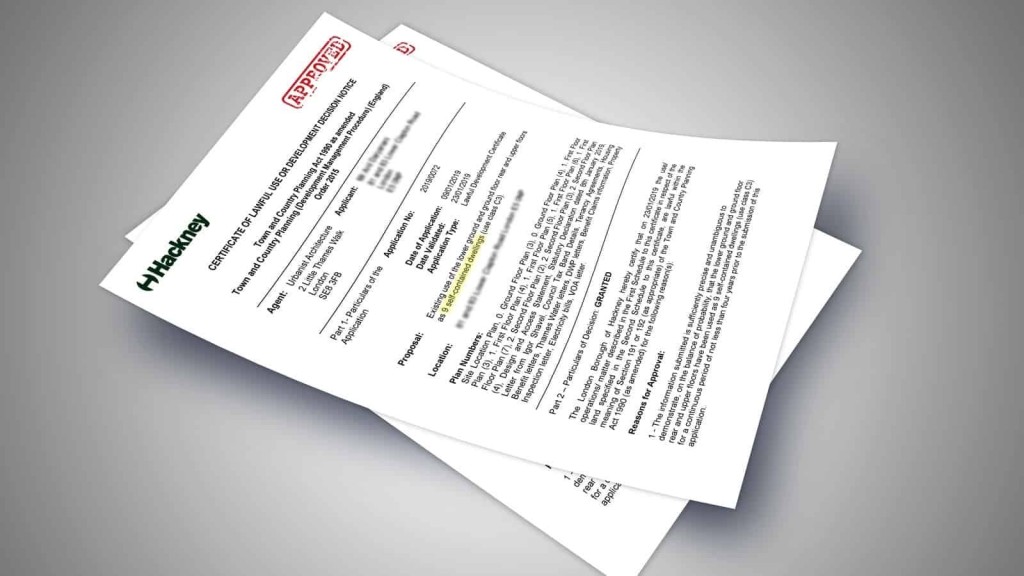
When our client approached us in 2019, they were facing a significant planning issue. Several years earlier, they had converted their property in Lower Clapton into nine self-contained flats without obtaining planning permission.
For years, these flats had been rented out to various tenants, generating steady income. However, with no formal approval in place, the development was at risk of enforcement action, which could have led to costly legal battles, financial penalties, or even a requirement to revert the property to its original use.
Given the scale of the conversion, this was not a straightforward case. The local authority would likely scrutinise an application for nine flats more closely than a typical subdivision into two or three units. Additionally, as with many rental properties, there had been tenant turnover, occasional void periods, and some gaps in documentation - all potential hurdles in proving continuous residential use for the required four-year period.
We knew that success depended on presenting an airtight case with compelling evidence. Our first step was to conduct a thorough audit of all available records, identifying any gaps that needed to be addressed.
To demonstrate that all nine flats had been in continuous residential use for at least four years, we compiled a robust application backed by tenancy agreements, council tax records, utility bills, bank statements, and postal correspondence addressed to multiple tenants over the years. Where official documentation was incomplete, we strengthened the case with sworn affidavits from long-term tenants, neighbours, and the landlord, providing first-hand confirmation of sustained occupation.
Understanding that planning officers would closely examine a case of this scale, we took a proactive approach. Instead of waiting for potential objections, we pre-empted them by structuring the application to clearly show how each flat had been occupied over time, even accounting for minor gaps in tenancy. We carefully explained why short void periods did not disrupt the overall lawful use of the property, reinforcing the argument with planning precedents.
Thanks to our strategic approach and meticulous attention to detail, we successfully secured a Certificate of Lawfulness for all nine flats. This provided our client with long-term security, protecting them from enforcement action and significantly increasing the property’s value. With formal recognition of the flats’ lawful use, the client could now continue letting them out without concern or explore refinancing and future development opportunities.
This case underscores the importance of a well-prepared, evidence-led approach when regularising unauthorised developments. Larger-scale conversions often attract greater scrutiny, making it crucial to present clear, indisputable proof of continuous use. It also demonstrates that gaps in documentation don’t have to mean failure - when supplemented with strong supporting statements, an application can still succeed.
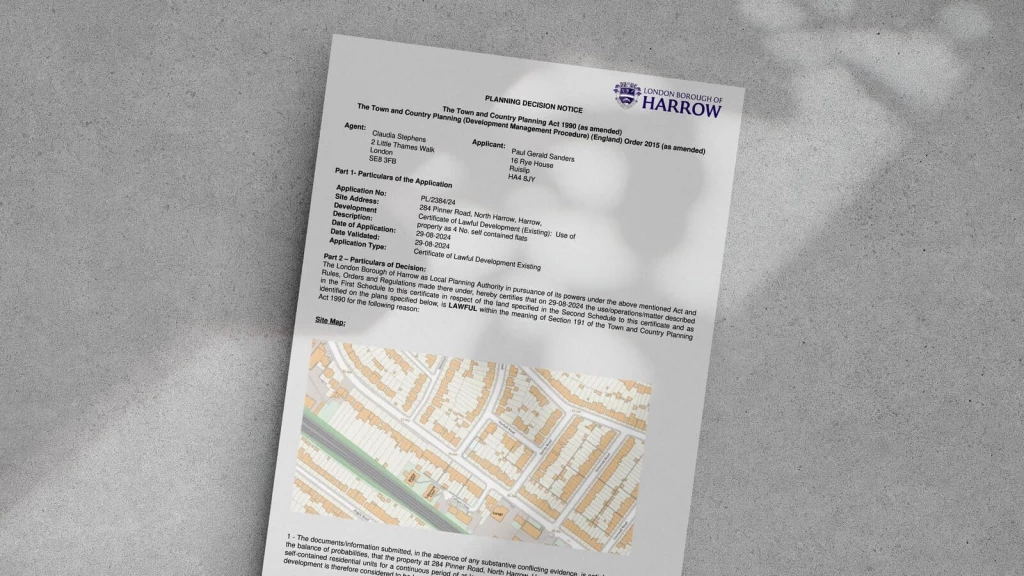
When our client approached us in 2024, they faced a critical legal hurdle. Back in 2014, they had divided their property in Harrow into four self-contained flats, each occupied by tenants for the past decade. However, the absence of formal planning permission meant there was a real risk of enforcement action.
The situation was further complicated by a recent policy shift. As mentioned, on 25 April 2024, the four-year rule, which previously allowed unauthorised residential conversions to be regularised after four years of continuous use, was replaced by the ten-year rule. This meant that securing a Certificate of Lawfulness was no longer a straightforward process. The key question was whether we could still make the case under the four-year rule.
Recognising the urgency, we meticulously examined the transitional provisions of the legislation. Since the conversion works had been substantially completed before the rule change, we built our case around the four-year rule rather than waiting an additional six years under the new ten-year requirement.
To demonstrate continuous use of the property as four distinct flats, we submitted a robust application with extensive evidence, showing not only the existence of the flats but also their uninterrupted occupation over the years. By structuring our case strategically and ensuring every detail was accounted for, we presented a compelling argument that left no room for doubt.
Through a well-documented and persuasive approach, we successfully demonstrated that the use of the property remained unchanged in both function and intensity across any chosen period of four or ten consecutive years. The council had no choice but to acknowledge the strength of our case.
As a result, our client was granted a Certificate of Lawfulness for Existing Use, officially regularising the four self-contained flats under the four-year rule.
This project highlights the importance of a detailed, evidence-led approach when navigating changes in planning law. At Urbanist Architecture, we don’t just respond to challenges - we anticipate and overcome them with expertise and strategic thinking.
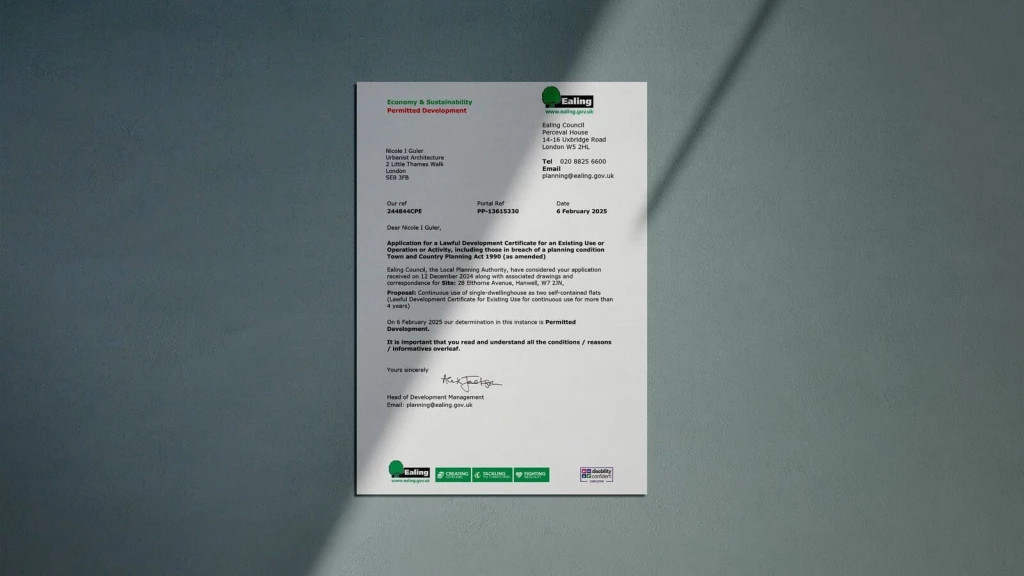
When our client approached us for help in securing a Certificate of Lawfulness for two flats in Hanwell, the case initially seemed similar to a previous success we had achieved under the four-year rule. However, there was one crucial complication - continuity of use.
Unlike other cases where properties had been continuously occupied, this property had a two-year gap in tenancies due to the landlord’s ill health. During this period, the flats remained unoccupied, raising concerns about whether the application could still succeed. Many assume that continuous occupation is an absolute requirement for securing a Certificate of Lawfulness, but planning law does not explicitly impose such a condition. The key question was whether this break in occupation would prevent the application from succeeding.
Understanding the nuances of planning law, we examined both the Levelling-Up and Regeneration Act and the National Planning Policy Framework. Neither made explicit reference to a continuity requirement for establishing lawful use. While local authorities often expect uninterrupted use, case law supports the position that a reasonable gap can be accepted if justified with strong evidence.
Rather than submitting standard documentation and hoping for the best, we took a proactive approach. We prepared a robust application, providing not only the standard evidence - such as tenancy agreements, utility bills, and council tax records - but also additional supporting documentation explaining the landlord’s personal circumstances. By clearly demonstrating the reasons behind the temporary vacancy and reinforcing the property’s long-term use as two self-contained flats, we pre-empted any concerns the planning officers might raise.
Through meticulous preparation and a well-substantiated case, we successfully demonstrated that the flats had been used as separate dwellings for a qualifying four-year period, even with the gap in occupancy.
The council acknowledged the strength of our evidence, and the Certificate of Lawfulness was granted, allowing our client to continue renting out the flats without the risk of enforcement action.
These cases underline an essential truth: in planning law, detail is everything. Assumptions - such as the belief that continuous occupancy is mandatory - can lead to unnecessary delays or refusals if not properly addressed. The more documentation you can provide to support your case, the better your chances of success.
At Urbanist Architecture, we ensure that every application is not only thorough but also anticipates and overcomes potential objections before they arise.

As we have said, getting a Certificate of Lawfulness is far from simple. Remember, you are trying to prove that you have done something the council did not want you to do, and get them to agree that there is nothing you can do about it.
Approving COL applications causes headaches for councils, because they then have to explain to people with no knowledge of the planning system why their neighbour has been allowed a flat conversion or an extension and they will not be able to have the same thing. So planning officers can be very tough when looking at these applications, looking for any holes in the evidence that has been presented.
That's why we are proud of our record with four and ten-year rule applications, many of them for flat conversions but also for roof terraces, the use of a garage as a home and various commercial cases. We're based in London, but we have worked on successful Certificate of Lawful applications in, for instance, Dover as well as South Norfolk.
Our rigorous feasibility process means that we will let you know if you have a good chance of succeeding well before we get to the point of submitting anything on your behalf.
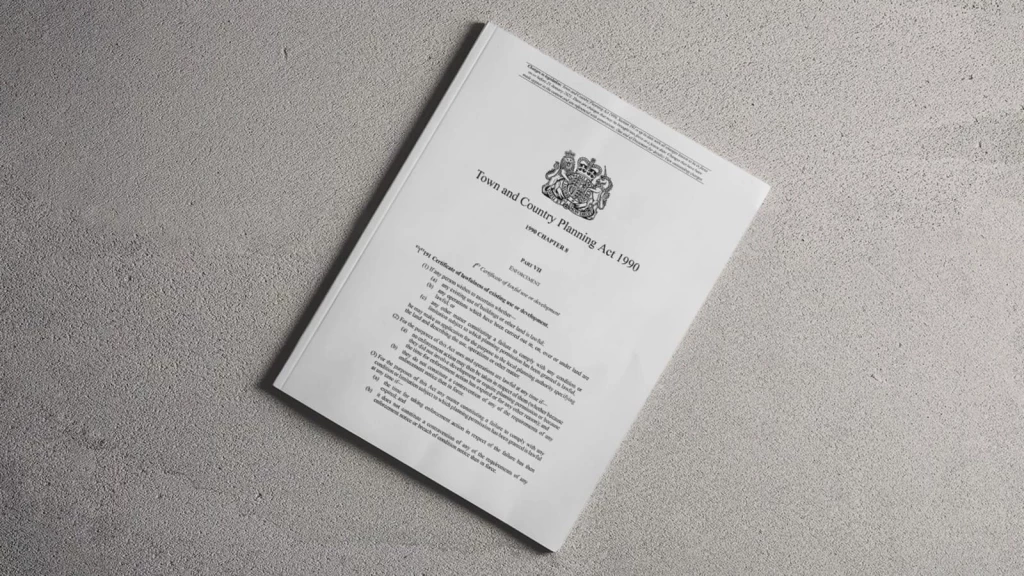
Applications for a Certificate of Lawfulness are governed by Section 191 of the Town and Country Planning Act (1990). This legislation sets out the criteria under which a Certificate of Lawfulness can be granted, confirming whether a specific use or development is legally established.
According to the Act, an individual may apply to their local planning authority to determine whether:
a. The existing use of a building or land is lawful;
b. Any operations carried out in, on, over, or under the land are lawful; or
c. Any failure to comply with a planning condition or limitation is lawful.
If any of these conditions apply, a Certificate of Lawfulness can be sought to provide formal confirmation of legal status.
The Act goes on to define an operation as ‘lawful’ if no enforcement action can be taken against it and if no enforcement action is already in place.
One key question that often arises in enforcement matters is whether a breach of planning control needs to be ongoing at the time an enforcement notice is served. The answer, as clarified in case law, is no.
In Patton v Secretary of State, the Court ruled that an enforcement notice can still be served even if the breach has ceased by the time the notice is issued. The Court explained that if enforcement action were only possible against ongoing breaches, individuals could evade consequences by temporarily stopping unauthorised use just before anticipated enforcement action, only to resume it later.
This ruling reinforces that local planning authorities retain the discretion to take enforcement action against past breaches if they consider it necessary to prevent further non-compliance. In other words, even if an unauthorised use or development has ended, enforcement action may still be taken if the local authority deems it expedient.
This is an important point: it’s not possible to apply for a Certificate of Lawfulness if enforcement action is in progress. That’s because a key element to prove here is the fact that you were unknowingly in breach of planning regulation – and enforcement, of course, would have brought this to your attention.
While the policy uses clunky language to explain this, it establishes a helpful route for avoiding the threat of any future enforcement that could negatively impact the property.
Besides, in Certificate of Lawfulness applications, the planning policies and the merits of the development are of no concern. The decision is solely based on the law and the evidence provided as to how the property has been used in the past. The onus is on the applicant to prove their case on the balance of probability.
Additionally, it is established law that in these cases, there is no need for independent evidence if the evidence provided by the applicant is clear, unambiguous, and convincing. Therefore, your planning consultants should aim to present a case that encompasses these three aspects.
A Certificate of Lawfulness is defined as a legal document that regularises unauthorised development. The former 4-year rule (now the ten-year rule) allows you to make a formal application to determine whether your unauthorised use has become lawful through the passage of time — rather than through its compliance with space standards and other planning requirements.
It, therefore, allows your use to continue without the need for planning permission.
In many ways, this is a desirable alternative to the other option available to you: applying for full planning consent through a retrospective planning application. The burden of proof here is much higher, because a full planning application requires the development to adhere strictly to national and local standards.
Anything that the council could consider a material planning consideration would be of relevance to a retrospective planning application. This could include factors like:
And that list is not even exhaustive. So, if you have the right evidence and are able to clearly prove that your property has been in continuous use over the designated period of time, then a Certificate of Lawfulness can be a far safer route to take in terms of regularising your permission.

We often get calls from HMO owners who are confused by the fact that they have a licence from the council for their HMO and yet they have been told there is a possibility of enforcement because they don’t have planning permission.
Planning permission is a legal authorisation granted by the local planning authority, which allows a proposed development to proceed. It ensures that any proposed development is in compliance with local planning policies and regulations, and takes into consideration factors such as the impact on the surrounding environment, infrastructure, and community.
On the other hand, property licensing is a regulatory framework that sets out the minimum standards for rented properties. It aims to ensure that rented properties are safe, habitable, and well-managed. Property licensing requirements vary across different local authorities and depend on the type of property being rented and the number of occupants.
While an HMO licence and building control approval do not equate to planning permission, they can serve as supporting evidence when applying for a Certificate of Lawfulness under the 10-year rule.
If your HMO has been in continuous use for over 10 years without enforcement action, these documents may help demonstrate the property’s long-term use.
However, additional evidence - such as tenancy agreements, council tax records, and sworn affidavits - will likely be required to satisfy the balance of probability needed for a Certificate of Lawfulness application.
Here is the key takeaway: An HMO licence does not mean you have planning permission. If your property was converted into an HMO without planning approval, you may still need to regularise its use by applying for a Certificate of Lawfulness - and for this, you must prove at least 10 years of continuous HMO use.

Urbanist Architecture is a London-based RIBA chartered architecture and planning practice with offices in Greenwich and Belgravia. We have a record of getting Certificates of Lawfulness granted that compares to any in the business.
To minimise your risks, get in touch today to discuss how we can help you understand the status of your property and give you the best chance to get it regularised.
Please note, we do not take on four-year rule applications for garden outbuildings used as housing.

Nicole I. Guler BA(Hons), MSc, MRTPI is a chartered town planner and director who leads our planning team. She specialises in complex projects — from listed buildings to urban sites and Green Belt plots — and has a strong track record of success at planning appeals.
We look forward to learning how we can help you. Simply fill in the form below and someone on our team will respond to you at the earliest opportunity.
The latest news, updates and expert views for ambitious, high-achieving and purpose-driven homeowners and property entrepreneurs.
The latest news, updates and expert views for ambitious, high-achieving and purpose-driven homeowners and property entrepreneurs.
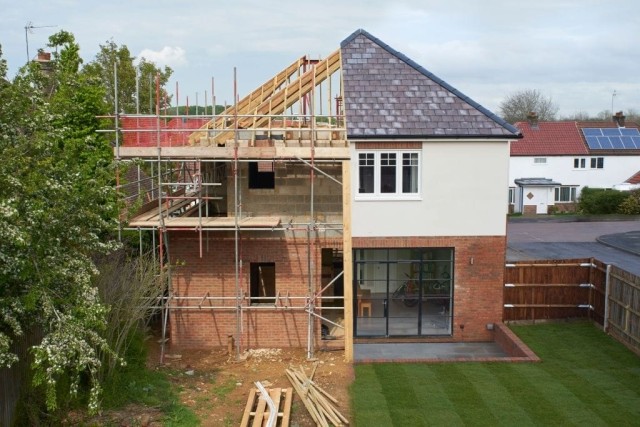

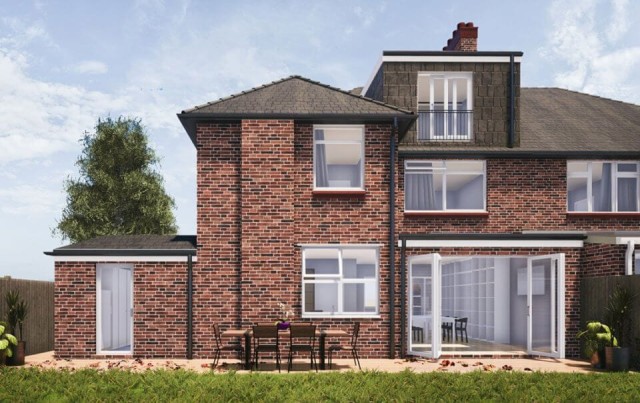
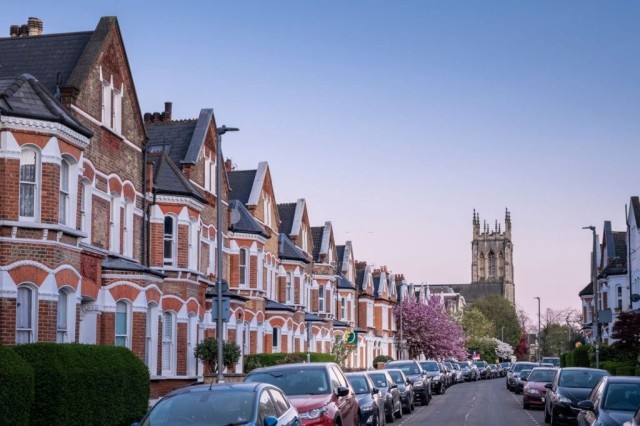

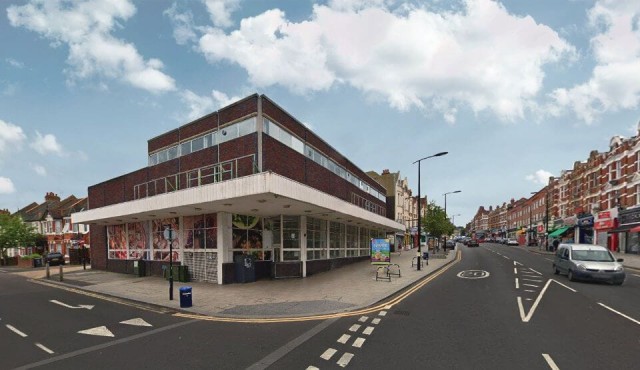
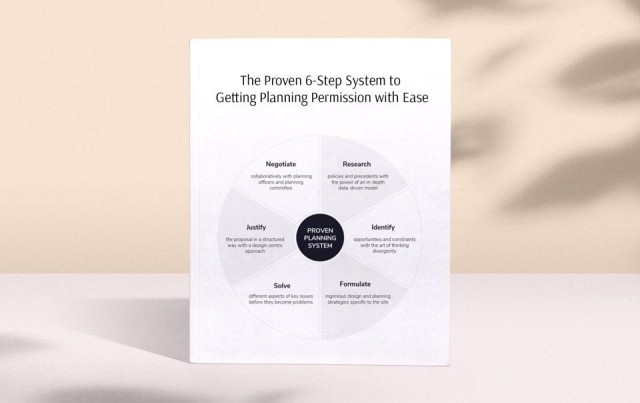
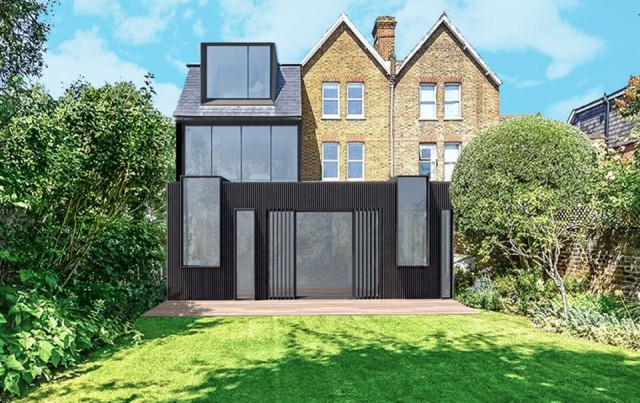

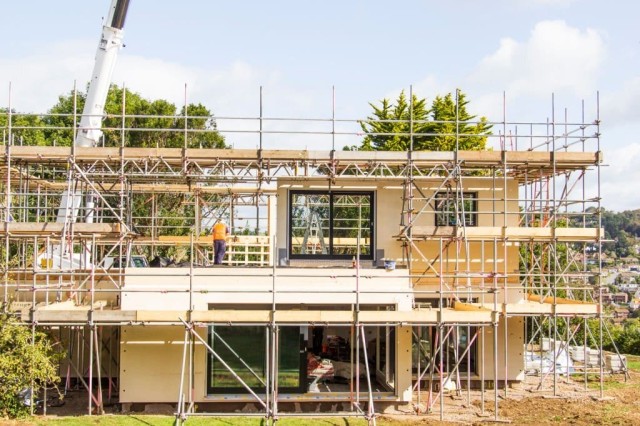
We specialise in crafting creative design and planning strategies to unlock the hidden potential of developments, secure planning permission and deliver imaginative projects on tricky sites
Write us a message